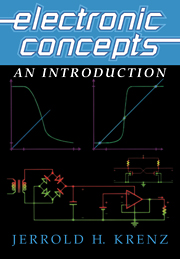Book contents
- Frontmatter
- Contents
- Preface
- 1 ELECTRONIC SYSTEMS: A CENTURY OF PROGRESS
- 2 THE SEMICONDUCTOR JUNCTION DIODE: THE BASIS OF MODERN ELECTRONICS
- 3 THE BIPOLAR JUNCTION TRANSISTOR: AN ACTIVE ELECTRONIC DEVICE
- 4 THE METAL-OXIDE FIELD-EFFECT TRANSISTOR: ANOTHER ACTIVE DEVICE
- 5 NEGATIVE FEEDBACK AND OPERATIONAL AMPLIFIERS
- 6 ELECTRONIC POWER SUPPLIES
- APPENDIX A FABRICATION OF INTEGRATED CIRCUITS
- APPENDIX B THE DESIGN PROCESS
- Index
5 - NEGATIVE FEEDBACK AND OPERATIONAL AMPLIFIERS
Published online by Cambridge University Press: 05 June 2012
- Frontmatter
- Contents
- Preface
- 1 ELECTRONIC SYSTEMS: A CENTURY OF PROGRESS
- 2 THE SEMICONDUCTOR JUNCTION DIODE: THE BASIS OF MODERN ELECTRONICS
- 3 THE BIPOLAR JUNCTION TRANSISTOR: AN ACTIVE ELECTRONIC DEVICE
- 4 THE METAL-OXIDE FIELD-EFFECT TRANSISTOR: ANOTHER ACTIVE DEVICE
- 5 NEGATIVE FEEDBACK AND OPERATIONAL AMPLIFIERS
- 6 ELECTRONIC POWER SUPPLIES
- APPENDIX A FABRICATION OF INTEGRATED CIRCUITS
- APPENDIX B THE DESIGN PROCESS
- Index
Summary
Negative feedback, when used with an amplifier, reduces the gain of the overall circuit because part of the output signal is used to “negate” a portion of the input signal. If properly designed, negative feedback circuits can result in improved performance characteristics – in particular, lower distortion, improved frequency and impedance characteristics, and a smaller dependence on supply voltages. To realize these benefits, an amplifier is required that has a gain considerably in excess of that which would otherwise be needed. With the advent of commercially produced integrated circuits, high-gain, low-cost amplifiers suitable for negative feedback circuits became readily available. Integrated circuit operational amplifiers (IC op amps) are now widely used “building blocks,” both as individual integrated circuits (replacing discrete transistors for many applications) and within more complex integrated circuits.
The concept of positive feedback electronic circuits predates that of negative feedback (Tucker 1972). Positive feedback was initially used to increase the gain of early low-gain vacuum tube circuits. With positive feedback (regenerative circuits), an enormous increase in the sensitivity of radio receivers was achieved. Only after high-gain amplifier circuits were developed in the 1920s did the concept of using negative feedback emerge. Harold Black is credited with having first proposed this concept in 1927. According to published accounts, the idea of an electronic amplifier with negative feedback was the result of a sudden insight that Black had while crossing the Hudson river by ferry on his way to work in Manhattan (Mabon 1975; O'Neill 1985).
- Type
- Chapter
- Information
- Electronic ConceptsAn Introduction, pp. 299 - 368Publisher: Cambridge University PressPrint publication year: 2000



